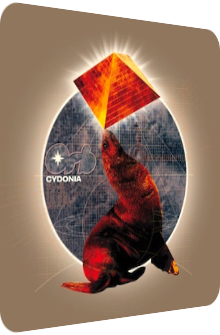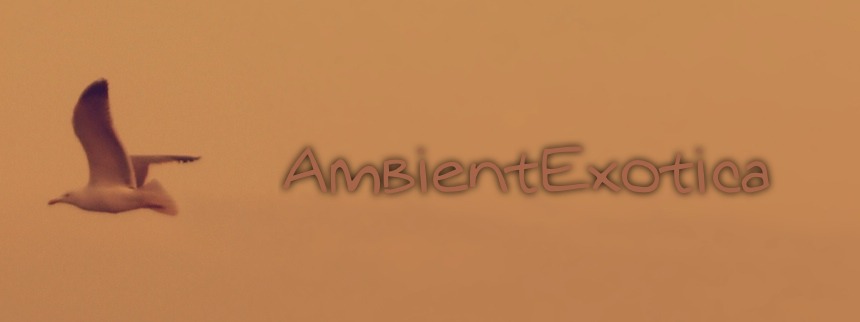
The Orb
Cydonia
2001
I am probably one of the bigger fans of The Orb you can find on the net, and of course I‘m aware about their fan-dividing styles that are so varied that they cannot please everyone. As a result, complaints of their old fans grew, why a new generation discovered the band‘s new sounds. The alleged downfall of the band started with Cydonia back in 2001. While this is a terrific album in my opinion, many fans complained about the band's change of style: whereas in the 90's their music consisted of either space opera-like soundscapes or earthen, field recording-heavy Ambient journeys – and believe me, the term journey is totally appropriate –, the 13 tracks (14 in the US-version) of Cydonia present a variety of changes to the band's sound that not everyone was willed to digest. A distinctive element are the four vocal tracks that feature the talents of Aki Omori and Nina Walsh, a first for The Orb. Naturally they remixed vocal tracks before, for example the obscure Lovekittens or Primal Scream, but they never came up with original tracks, let alone their own lyrics. Secondly, the band ventures into Drum & Bass or Jungle territories, a fact that many people disliked as well. The hatred for the album, I believe, can be pinpointed to another phenomenon, though. Cydonia was scheduled for a release in 1999 already, but marketing decisions of their label Island Records and the leak of various Cydonia versions of the then highly popular Napster peer to peer filesharing system caused the band to go back to the drawing board under the guidance of Dr. Alex Paterson who gathered his satellite members, among them Thomas Fehlmann, Simon Phillips and the recently deceased Andy Hughes who left the band when the album was in transit. Paterson started anew by throwing off a few tracks and leaving 6 of the original tracks in. Since diehard fans already adapted to the promo versions of Cydonia, nicknamed as Cydonia 1.0, the shock was quite big when beloved tracks were left out and substituted by even more vocal tracks. So, this is basically the background story about Cydonia, and while all of the left out tracks can now be found on the Orbsessions Volume 2 compilation of rare tracks by the band, the annoyance about the final version of Cydonia remains. However, I am very fond of this album, as I will explain below.
The album starts with the iconic Once More, an Italo piano-driven New Age pop song with Aki Omori's multiplied voice, gurgling water and gorgeously elevated synth backings and flittering pulses. This song already shows in a nutshell what went wrong with Cydonia, for there is an even better mix of this tune on Cydonia 1.0 with Omori's voice more embedded in the mix, an additional glistening synth melody and an aquatic closing phase with prolonged water streams. The Orb changed this song for the sake of change. Even more curious is the music video of Once More which is yet again mixed differently. Anyway, the best version that is featured on Cydonia 1.0 has never been officially released. Quite a shame. The next track, though, offers reconciliation big time: Promis (named after the PROMIS period) is taken from Cydonia 1.0 and is completely unchanged. It's one of The Orb's strongest tracks below the 6 minute mark and offers anything but pure bliss and effervescent happiness. Bouncy beats and swashbuckler-esque accordion-like melodies form the background of a sampled Oriental string section and swooshing sound effects that spice the second half of the song with Jungle percussion, tremendously joyful synth bursts and an exuberant Far Eastern flute outro complete with xylophonic wind chimes. All ingredients fit together like magic, making this a very, very strong track overall. Highly recommended, regardless of your taste in music. The following Ghostdancing is again unchanged from its first incarnation, featuring the voice talents of Nina Walsh in a melancholic but dubby atmosphere loaded with exotic clangs, twanging boings and vestigial melodies. This song is all about Walsh's voice and the bassline, and it is only in the refrain that the song grows larger with iridescent sustains. Turn It Down is the last of the first four songs that have survived the original running order. It is based on a steady 4/4 beat, mysteriously metallic clangs, sneaky melodies, acidy pads plus morphed hi hats whose pitch goes up and down rhythmically. The middle section might be off-putting for many a listener as it features detailed memories from Welsh citizens about milk beer in the World War II decade in a beatless section. To my mind, though, this is the strongest peculiarity of the song, and once the beats are dropped again, an additional electric guitar enhances the pressure before the song fade out.
After two short interludes, A Mile Long Lump Of Lard enters, which is a collaboration with Fil Le Gonidec of Autolump and the penultimate track off *Cydonia 1.0* but is again changed into something different. The original is a 10 minutes long Industrial track with harsh sizzles and energetic "You can feel the flash, you can feel the heat" samples that remind of the Atomic Age. This sample still made it to the released version, but it is much reduced and the song itself more laid back, throwing away most of the mechanic, machine-like dissonances. Added elements consist of whirling synth pads and a growing drone loop that reminds of a booting machine of destruction. The permanent presence of acid hooks and the powerful samples add another change of style to The Orb's roster. The following Centuries is the first of five new tracks in a row that were specifically written for the final release of Cydonia, i.e. the version I am reviewing. Aki Omori goes back to the studio with The Orb and delivers a Björk-like performance on a gorgeous pop song. I'm not kidding, the song is hugely positive and the lyrics about the possibility of deleting horrific memories in the near future and the bonds of friendship are quite deep. A sample of a hectically ticking clock is repeated endlessly, and the warm synth pads and gleaming mellifluence of the backing bits point to the clear trademark sound of Thomas Fehlmann. I can totally relate if this song is hated by fans and enemies alike, but the brightness of Centuries somehow moves me and brings me in a good mood. The following Plum Island doesn't link to Silence Of The Lambs, but is the most dubby and reduced track on the album with huge basslines, clicking percussion, a paradisiac flute and echoey, spectral voice snippets by Nina Walsh that are hard to understand. The refrain is all the stronger and rather catchy and it is here where the isolated, lonesome flute melody is heard. Another deep, minimal song whose beauty is built upon the lack and not the variety of its ingredients.
Up next is Hamlet Of Kings, also known as 4 Horsemen, though not related to the song of the same name by Metallica. This collaboration with Guy Pratt, formerly affiliated with Pink Floyd, is the second one after the famous track Spanish Castles In Space off The Orb‘s 1991 debut Adventures Beyond The Ultraworld. Here, Pratt delivers ginormously vibrant bass lines and huge beats, while Paterson intermingles samples of cascading harps, probably taken off an audio playbook for children, a distinctive 3-note theme on a synthetic bamboo, beautifully soothing synth swirls and a slightly eerie synth choir motif next to an incessantly looped sound of a beer that is poured into a hump. Later on, the famous Big Ben bells are interwoven and a few pluckings on a steel guitar are added as well before the song fades out slowly with clichéd vinyl scratches. Once again, the elements used on in Hamlet Of Kings don't seem to fit together on paper, but are successfully merged nonetheless. A very strong favorite of mine that shows in compressed form what The Orb were about at the turn of the millennium. Thursday's Keeper is a beast of a Jungle track with acid lines, rising basslines, piercing percussion and fragments of Malcolm McLaren's Buffalo Girls. Another distinctive trademark of the track is the trumpet fanfare that has been featured on many a Saturday morning cartoon. Never before have The Orb neglected their Ambient roots this strongly. I don't care much for its setting, though I have to admit that it is added to my workout playlist freqqently as it is a perfect foil for sporty movements. The final, aptly titled Terminus is an 11+ minutes long vintage Orb song that inherits everything that is right about the band. It could be considered the last real Orb track that contains their typical flavor. It is loaded with funny samples, swirling synth melodies, fragments of Hidden by FFWD and meandering, ever-pulsating synth strings that are warm, care-free and just beautiful due to their multiple layers and organic qualities. In he middle of the track, gentle percussion is added, but it never distracts from the swirling synths and the glitzy, cherubic melodies. The best track off Cydonia for sure, regardless of your preferred style. This is a proper Ambient Dub track and so utterly beautiful that you have to listen to it for yourself if you don't know it yet.
In the end, I don't understand to this day why the release was panned by the press and numerous fans alike. The vast majority of the Ambient or Dub tracks – the Pop tracks included – are so utterly wonderful that their illuminated aura outshines the boring interludes and the harsh Jungle tracks. Only Terminus is a remnant of the band's dominant style of the 90's, but the band eventually mastered the transition into the next millennium. Compared to the following albums, Cydonia is luxuriously wadded in synthscapes and mellow hooks. I am myself one of the fans that long for the old days of super-long Ambient tracks full of surprises, funny samples and successful experiments, but Cydonia really isn't that bad. However, it isn't the most original work either, especially when you consider the band's impetus in terms of the Ambient House movement and their space explorations. Cydonia, while named after the Mars region, doesn't offer anything galactical, but is more down to earth with its harp and water samples. All four vocal tracks are very good; my love for Exotica records probably helps me quite a bit in endorsing the poppier side of The Orb. However, I also have to admit that there is no overarching theme to the album, which is also a sad first for the band, who delivered various concept albums beforehand. To close this review for now, let me recommend Promis as the very best Jungle track, Centuries as the most beautiful Pop song and Terminus as a proper vintage Orb track to you. Chances are good that you like all three of them.
Further reading:
The best website in terms of samples used by The Orb can be found here. Kudos to this year-long project that is now available in archived form.
Ambient Review 052: The Orb – Cydonia (2001). Originally published on Mar. 28, 2012 at AmbientExotica.com.
